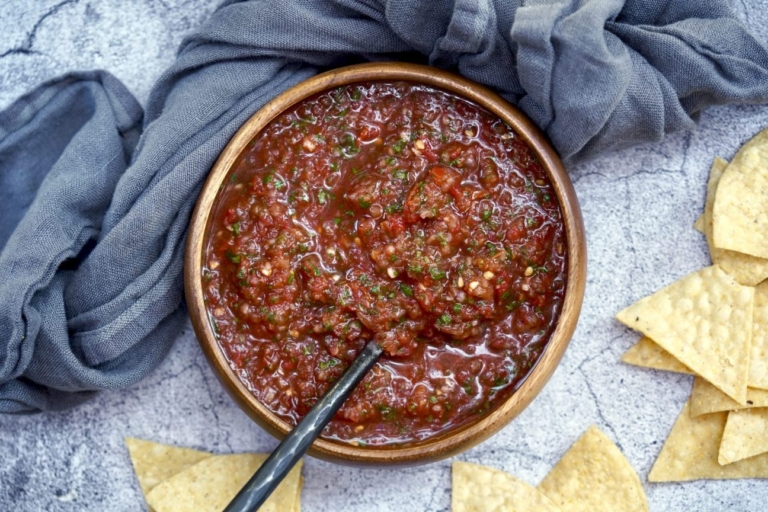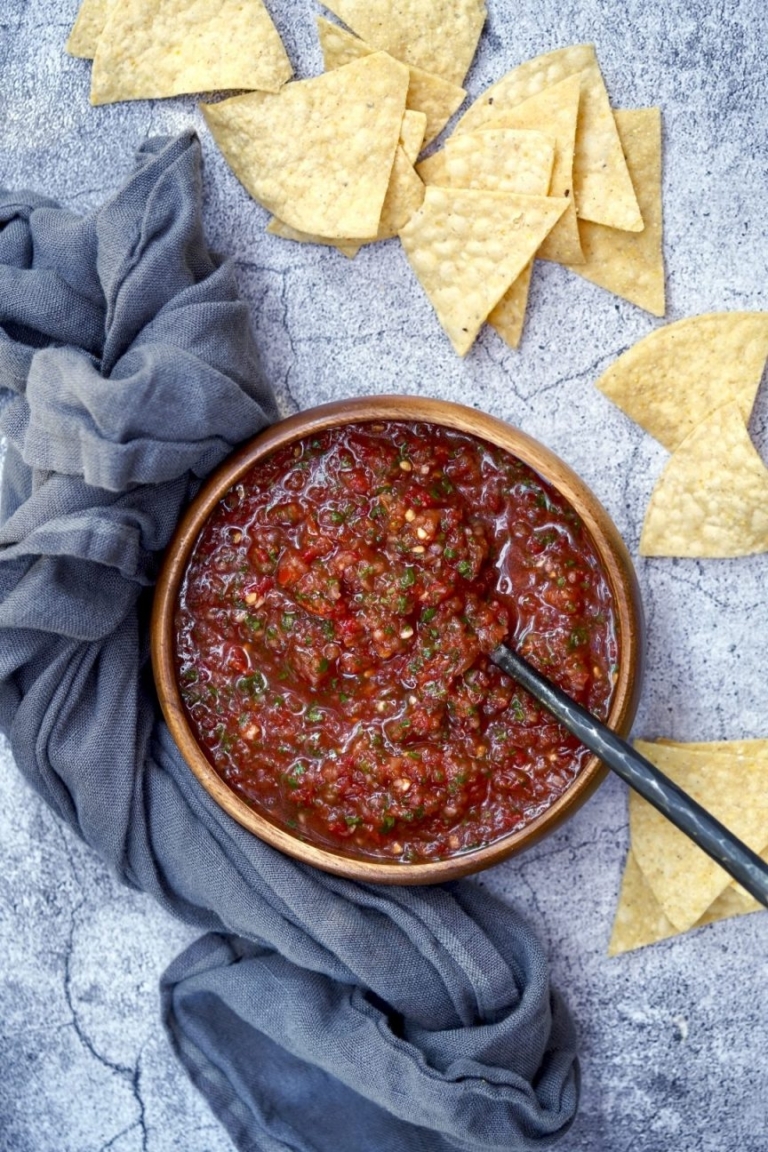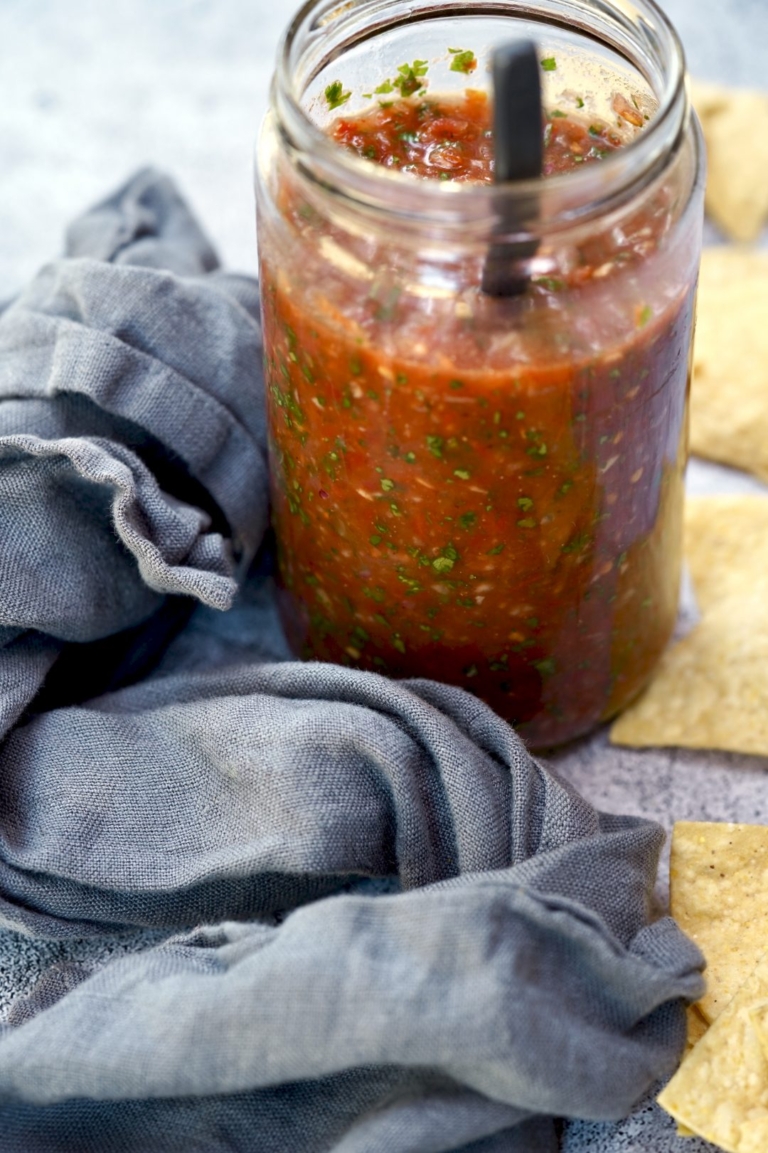Fresh Tomato Salsa

Fresh tomato salsa is a favorite condiment of mine and one I’ve been making a ton lately. This often-overlooked side dip is easy, flavorful, and incredibly adaptable. Salsa is a simple combination of chilies, tomatoes, and other spices that have been around for centuries.
Food historians can trace a form of salsa back to the Aztecs, Mayans, and Incas. The Spaniards first encountered tomatoes after their conquest of Mexico in the early 1500s. This marked the beginning of salsas history. Aztec lords were the ones who thought to combine tomatoes with chili peppers, and ground squash seeds, and served it alongside turkey, venison, and fish.
History tells us salsa didn’t spread outside Central American cuisine until the Spaniards arrived and conquered Mexico, between 1519 and 1521. In 1571, a Spanish priest first coined this tomato-based condiment “salsa“. And for those that don’t already know it, “salsa“, directly translated from Spanish, simply means “sauce”.
Today, salsa like mine, is a mix of Old and New World ingredients. Tomatoes, tomatillos, and chilies are native to the Western Hemisphere, while the added spices, such as onions and garlic, are derived from Old World origins. An increase in the popularity of spicy foods and hot sauces began in the mid-1800s. This trend started in Texas and the Southwest but quickly spread throughout the US. Quickly, Americans have been obsessed with salsa. Today, salsa is now considered a standard in American cuisine and is no longer considered an “ethnic food.” In 2013, salsa won the title “the new American condiment king“, beating out ketchup by a landslide.
Common Salsa Varieties
- Salsa Roja: (Red sauce) usually includes cooked tomatoes, chili peppers, onion, garlic, and fresh cilantro.
- Pico De Gallo: (Rooster’s beak) also known as salsa fresca, salsa picada, or salsa Mexicana typically made with raw tomatoes, lime juice, chilies, onions, and cilantro leaves.
- Salsa Cruda: (Raw sauce) is an uncooked mixture of chopped tomatoes, onions, jalapeño chilies, and cilantro.
- Habanero Salsa: An extremely spicy salsa, where the potency comes from the hot habanero chilies.
- Salsa Verde: (Green sauce) in Mexican versions, is made with tomatillos, usually cooked.
- Salsa Negra: (black sauce) is a Mexican sauce made from dried chilies, oil, and garlic.
- Chipotle Salsa: A smoky, spicy sauce made from smoked jalapeño chilies, tomatoes, garlic and spices.
- Salsa Taqueria: (Taco sauce) made with tomatillos and morita, but in n the U.S., commonly contains tomato puree, vinegar, and chili pepper.
- Salsa Ranchera: (Ranch-style sauce) made with roasted tomatoes, chilies, and spices, typically served warm.
- Avocado Salsa: Made from fresh avocado, lime, cilantro, jalapeño or serrano peppers, garlic, olive oil, cumin, and salt.
- Mango Salsa: A spicy-sweet sauce made from mangoes, used as a topping for nachos. Commonly used as a garnish on grilled chicken or fish.
- Pineapple Salsa: A sweet-spicy sauce made from pineapples often used as an alternative to mango salsa.
- Corn Salsa: A chunky-style salsa made with sweet corn, onions, chiles, and either poblano, bell chilies, or jalapeño peppers.
Mexican salsas were traditionally produced using a mortar and pestle. Although shortcuts can be a good thing sometimes. For this recipe, I use a food processor, and fresh salsa in my house only takes 5 minutes to whip up with or without tacos and guacamole.
Fresh Tomato Salsa
Ingredients:
- 5-6 ripe plum or beefsteak tomatoes, roughly chopped
- 1/4 cup yellow onion, roughly chopped
- 1/4 cup red onion, roughly chopped
- 2 garlic cloves, peeled and smashed
- 1/2-1 jalapeño pepper, seeded and roughly chopped
- 1/3 cup fresh cilantro
- 1 tablespoon freshly squeezed lime juice
- 1/2 teaspoon chili powder
- 1/4 tsp ground cumin
- 1 1/2 teaspoon Kosher salt
- 1/8 teaspoon black pepper
Directions:
- In the bowl of a food processor, fitted with a blade attachment, add the tomatoes, yellow onions, red onion, garlic, jalapeño, cilantro, lime juice, chili powder, cumin, salt and black pepper and pulse on/off until all ingredients are finely chopped.
- Store in a large glass jar or container. Fresh salsa keeps, refrigerated, for five days.





Salsa made with fresh tomatoes has never ever turned out that deep red colour for me. I have used beautiful red ripe tomatoes, and it still turns out unappetisingly pinkish due to the other ingredients. I find that pico de gallo is the best outcome for fresh tomatoes. If you want salsa this colour, you have to use tinned tomatoes.
Hi Emily, thanks for your comment. I get what you are saying, that can happen at times. The type of tomatoes used and how ripe they are does make a difference, as does how much you process them if using a food processor. Hand chopping the tomatoes can help with this.
Absolutely delicious!
Thank you Janice! I so appreciate you taking the time to tell me this. Be well and keep on cooking!